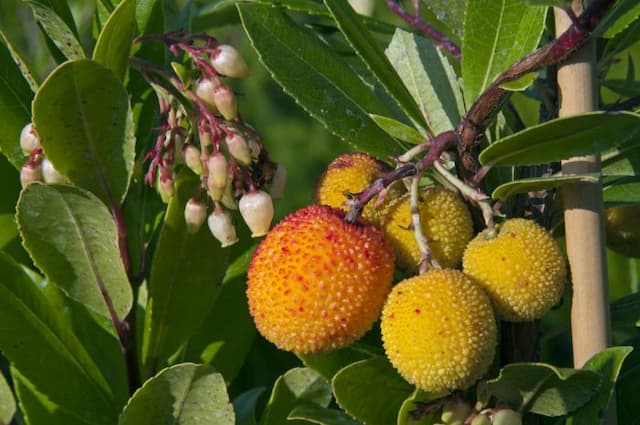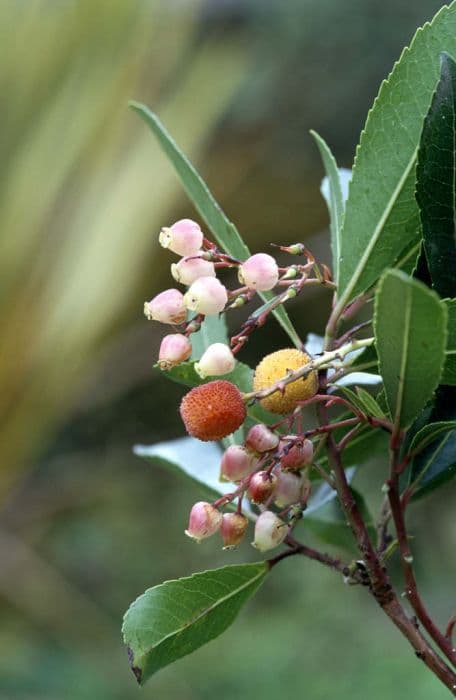Watson's Heath Erica × watsonii 'Dawn'

ABOUT
Erica × watsonii 'Dawn', also known as Heather 'Dawn', is a charming evergreen shrub that is prized for its prolific display of flowers. This plant boasts a dense, bushy habit consisting of fine needle-like foliage that has a soft texture. The leaves are small and narrow, typically a rich green color that remains vibrant throughout the year, providing a lovely backdrop for the blossoms. The true splendor of Heather 'Dawn' lies in its flowers, which appear in profusion from late winter to mid-spring. The blooms are bell-shaped and arranged in clusters along the stems. Each flower is delicate in size, with a color palette that ranges from a soft, pale pink to a more vibrant rosy hue. The blossoms can cover the plant so thoroughly that the foliage is almost obscured by the show of color. Erica × watsonii 'Dawn' provides year-round interest, with its evergreen foliage and early seasonal flowering that brims with color during a time when many other plants are still dormant. The delicate appearance of the blooms, combined with the fine texture of the foliage, gives this plant a soft, almost feathery appearance that can add both color and texture to a garden setting.
About this plant
 Names
NamesFamily
Ericaceae.
Synonyms
Watson's Heath, Dawn Pink Heath, Winter Heath.
Common names
Erica × darleyensis 'Dawn', Erica × darleyensis f. albiflora 'Dawn'
 Toxicity
ToxicityTo humans
Commonly known as Heather, Erica × watsonii 'Dawn' is not typically considered toxic to humans. However, if ingested in large quantities, it could potentially cause stomach upset. Despite not being highly poisonous, it is advisable to avoid eating any part of this plant, as it is not intended for consumption.
To pets
Heather, the common name for Erica × watsonii 'Dawn', is also not generally toxic to pets. While it is not known to be poisonous, ingestion of the plant in significant amounts could lead to gastrointestinal discomfort or upset in some pets. Therefore, it's best to keep an eye on pets and prevent them from consuming the plant.
 Characteristics
CharacteristicsLife cycle
Perennials
Foliage type
Evergreen
Color of leaves
Green
Flower color
Pink
Height
1-2 feet (30-60 cm)
Spread
1-2 feet (30-60 cm)
Plant type
Shrub
Hardiness zones
7
Native area
Europe
Benefits
 General Benefits
General Benefits- Ornamental Appeal: Adds visual interest to gardens with its vibrant pink flowers that bloom from late winter to early spring.
- Habitat Support: Provides nectar for pollinators like bees when other food sources are scarce.
- Low Maintenance: Requires minimal care once established, making it ideal for gardeners of all levels.
- Drought Resistance: Once established, it can tolerate periods of drought, reducing the need for frequent watering.
- Winter Interest: Maintains structure and color in the garden during the winter months when other plants may die back.
- Borders and Groundcover: Suitable for creating borders or groundcover, helping to suppress weeds and cover bare spots in the landscape.
- Soil Erosion Control: The plant’s root system can help to stabilize soil on slopes, preventing erosion.
- Versatility: Can be grown in containers, rock gardens, or as part of general garden beds.
 Medical Properties
Medical PropertiesThis plant is not used for medical purposes.
 Air-purifying Qualities
Air-purifying QualitiesThis plant is not specifically known for air purifying qualities.
 Other Uses
Other Uses- Artistic inspiration: The Heather 'Dawn' can inspire artists with its vibrant colors, providing a natural muse for paintings or botanical illustrations.
- Natural dye source: The flowering parts of Heather 'Dawn' can potentially be used to extract natural dyes for fabric or wool coloring.
- Beekeeping attractant: Planting Heather 'Dawn' nearby can attract bees and enhance honey production with its nectar-rich blooms.
- Culinary decoration: While not a common practice, the flowers of Heather 'Dawn' can be used as decorative, edible garnishes on cakes or desserts.
- Educational tool: This hybrid plant can be used in educational settings to teach hybridization and plant breeding techniques.
- Garden photography: Heather 'Dawn' provides a stunning subject for garden photographers, especially when capturing the beauty of frost-laden blooms.
- Miniature gardens: Due to its compact size, Heather 'Dawn' is suitable for creating detailed miniature gardens or fairy gardens.
- Erosion control: When planted en masse, Erica × watsonii 'Dawn' can help stabilize soil and prevent erosion on slopes.
- Crafting materials: Dried sprigs of Heather 'Dawn' can be used in flower arranging or to create natural, rustic wreaths.
- Seasonal celebrations: In some cultures, Heather is associated with luck and protection; 'Dawn' can be incorporated into festivities or rituals.
Interesting Facts
 Feng Shui
Feng ShuiThe Heather is not used in Feng Shui practice.
 Zodiac Sign Compitability
Zodiac Sign CompitabilityThe Heather is not used in astrology practice.
 Plant Symbolism
Plant Symbolism- Endurance - This plant is a hybrid of the Erica (heather) genus, which is known to be hardy and resilient, often associated with the ability to withstand challenging conditions.
- Admiration - Just as with many heather species, Erica × watsonii 'Dawn', or Winter heath, can symbolize admiration for someone's beauty or strength, as the plant itself exhibits delicate beauty and a robust nature.
- Protection - Heather plants have traditionally been thought to have protective qualities, warding off danger and bad luck, which can extend to this variety as well.
- Good Luck - Carrying over from the general symbolism of heathers, Winter heath may also be considered a good luck charm, potentially bringing fortune to those who possess or plant it.
- Solitude - Heathers, including Winter heath, can grow in remote and barren landscapes, often symbolizing a content solitary life or the enjoyment of one's own company.
 Water
WaterThe Winter Heath should be watered regularly to maintain a consistently moist soil, especially during dry periods. Water this plant deeply once a week, providing about a gallon of water per plant, ensuring you're not just wetting the surface but soaking down to the roots. The exact frequency of watering can vary depending on climate and soil conditions, but the key is to avoid letting the soil dry out completely while also preventing waterlogged conditions which can lead to root rot. During the winter, when the plant is dormant, reduce watering but do not allow the soil to become bone dry.
 Light
LightWinter Heath thrives best in full sun to partial shade conditions. The ideal spot for this plant is one where it can enjoy at least four to six hours of direct sunlight daily, with some protection from the intense afternoon sun in hotter climates. Morning sunlight is particularly beneficial, promoting vibrant flowers and healthy growth without the potential stress of midday heat.
 Temperature
TemperatureWinter Heath is hardy and can tolerate a range from about 20°F to 70°F, but it prefers cooler environments between 60°F and 70°F. It can survive winter temperatures down to 20°F; however, it's best to avoid exposure to extreme cold for prolonged periods. Providing a layer of mulch can help protect the roots in colder weather.
 Pruning
PruningPrune Winter Heath to reshape the plant and encourage bushier growth, typically right after it finishes flowering in the spring. Lightly trim back the tips of the branches, removing any spent flowers and up to one-third of the plant's height if necessary. Pruning should be done annually to maintain its compact form and to prevent the center from becoming too woody and bare.
 Cleaning
CleaningAs needed
 Soil
SoilWinter Heath 'Dawn' prefers well-draining, acidic soil with a pH of 4.5 to 6.0. A good soil mix for this plant would be equal parts peat, sand, and loam, which ensures good drainage and the right acidity.
 Repotting
RepottingWinter Heath 'Dawn' should be repotted every 2 to 3 years or when the plant has outgrown its current pot. Early spring is the best time to repot this plant.
 Humidity & Misting
Humidity & MistingWinter Heath 'Dawn' thrives best in moderate humidity. It can tolerate some dry air but not prolonged dry conditions. The ideal humidity range is between 50-60%.
 Suitable locations
Suitable locationsIndoor
Place Winter Heath 'Dawn' in bright, indirect light indoors.
Outdoor
Plant Winter Heath 'Dawn' in acidic soil with partial shade.
Hardiness zone
5-7 USDA
 Life cycle
Life cycleErica × watsonii 'Dawn', commonly known as Watson's Heath, starts its life cycle as a seed, which after germination in well-drained acidic soil, grows into a small seedling. The seedling then develops into a young plant, producing a woody stem and needle-like leaves, adapting to various light conditions but preferring full sun or partial shade. As the plant matures, it enters the flowering stage, generally in late winter to early spring, displaying clusters of bell-shaped, pinkish flowers that are attractive to pollinators. After pollination, the flowers develop into small seed capsules containing numerous tiny seeds that are dispersed by wind or wildlife, completing the cycle. If conditions are favorable, these seeds will germinate, giving rise to new seedlings. Throughout its life, Watson's Heath can be pruned after flowering to maintain its compact shape and encourage new growth.
 Propogation
PropogationPropogation time
Spring-Early Summer
For the plant known commonly as Heather, Erica × watsonii 'Dawn', the most popular method of propagation is by softwood cuttings. This technique is best performed during the late spring or early summer when new growth is still tender and green. Cuttings should be 2 to 4 inches long, with the lower leaves removed, and dipped in a rooting hormone to enhance root development. The treated cuttings are then placed into a well-draining potting mix and kept under high humidity conditions with plenty of indirect light. To retain moisture and provide the necessary humidity, a plastic cover or a propagator can be used. It usually takes a few weeks for cuttings to root, after which they can be gradually acclimatized to normal conditions before being transplanted into individual pots or garden beds.









